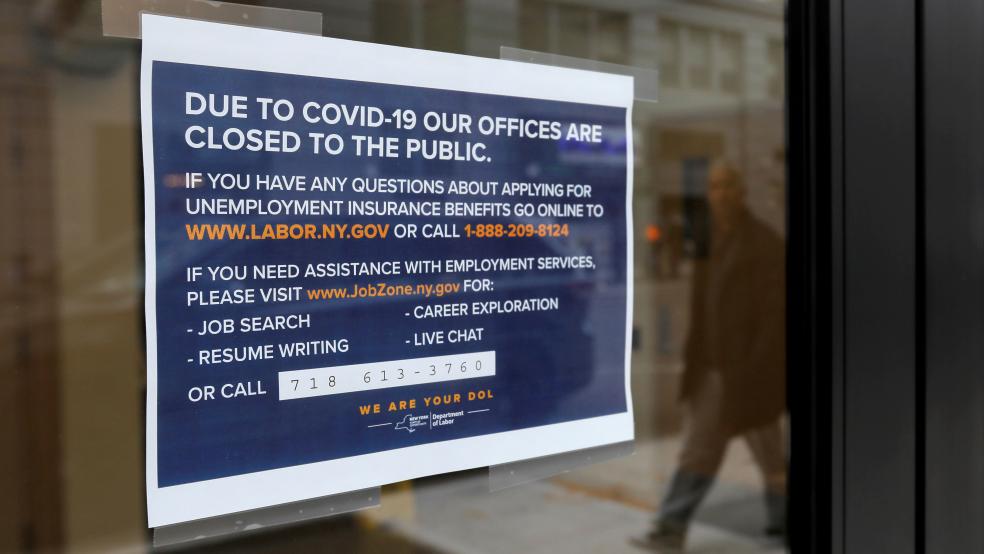The U.S economy set new records last month for job losses and the unemployment rate, the Labor Department announced Friday, as the coronavirus pandemic took an enormous toll on economic activity throughout the country.
Nonfarm payroll employment fell by 20.5 million during the month, driving the unemployment rate to 14.7%.
The job loss numbers reflect the largest monthly employment contraction in U.S. history, dwarfing the monthly totals seen during the 2008-2009 recession and the previous record set just after World War II. The unemployment rate is now the highest since the Great Depression.
The sheer size of the crisis: "The number of workers who swiftly lost work in April is beyond belief," said Nick Bunker of Indeed Hiring Lab. "With today's report, the full scope and scale of the current labor market crisis is only now coming into focus."
Labor force participation plunges: The labor force participation rate fell to 60.2% in April — the lowest since January 1973. And the employment-to-population ratio dropped to 51.3%, reflecting the largest one-month decline and the lowest reading in U.S. history.
Hospitality sector hit hard: The leisure and hospitality sectors lost 7.7 million jobs — nearly half of all employment in hotels, bars, restaurants, tourism and travel — and those losses accounted for 37% of the total for the month. In other sectors, retail shed 2.1 million jobs, manufacturing lost 1.3 million and white-collar sectors saw 2.1 million job losses. State and local governments also started cutting back, with nearly 1 million layoffs. And in what may seem odd during a health crisis, the medical sector lost 1.4 million jobs as elective procedures were put on hold and Americans avoided the health care system whenever possible.
Big differences by education: The unemployment rate soared to 21.2% for those without a high school degree, a record high. College graduates registered an 8.4% unemployment rate, while 17.3% of those with a high school degree were out of work.
The true numbers are probably even worse: Economists say that timing and measurement issues almost certainly underestimate the true extent of the damage. Michael Feroli of J.P. Morgan said, factoring in all the people who had left the workforce and those who were likely misclassified as “employed but not at work due to other reasons,” the unemployment rate would be closer to 23%. The Bureau of Labor Statistics agreed on the general point, saying the unemployment rate would have been nearly five points higher had more “absent from work” people been included.
More federal aid is probably needed: “This unemployment rate should be a real kick in the pants -- and maybe even the face,” former Federal Reserve economist Claudia Sahm told The Washington Post. “Congress has to stay the course on aid until more people are back at work.”
Trump says he’s not worried — and not to blame: Speaking to “Fox & Friends” Friday morning, President Trump was sanguine about the report. “It's fully expected. There's no surprise. Everybody knows this," he told the show’s hosts. “Somebody said, ‘Oh, look at this.’ Well, even the Democrats aren't blaming me for that. But what I can do is I'll bring it back.”
A glimmer of hope: The share of people who said they are unemployed on temporary basis soared to a record 80% in April, more than three times the level in March. “Such a large share of temporarily unemployed Americans indicates they may be able to return to their previous employers quickly as the nation emerges from the economic stoppage,” says Vince Golle of Bloomberg News.
But long-term picture is far from rosy: Economists say that the longer the crisis goes on, the more likely that temporary job losses will become permanent. “This is pretty scary,” Lindsey Piegza, chief economist at Stifel, told the Post. “I’m fearful many of these jobs are not going to come back and we are going to have an unemployment rate well into 2021 of near 10 percent.”
Joseph Brusuelas, chief economist at consulting firm RSM, told Politico’s Ben White that the U.S. has a tough road ahead, despite what some political leaders are saying about a quick recovery. “We have to be utterly realistic about this because there is political fantasy out there and then there is economic reality. It is going to be years before we recover all of these lost jobs and as much as 25 percent of them aren’t ever coming back.”





